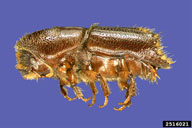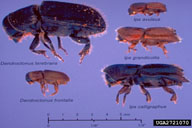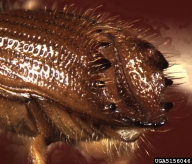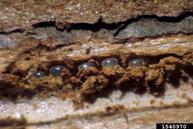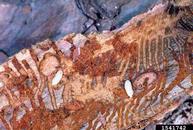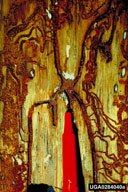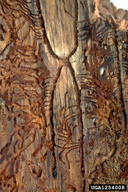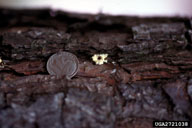Six-spined Ips
Ips calligraphus (Germar) (Coleoptera: Curculionidae, Scolytinae)
Orientation to pest
The six-spined Ips, Ips calligraphus (Germar), is a native bark beetle found in both the eastern and western United States. Two subspecies of I. calligraphus are recognized that occur in the United States. Ips calligraphus ponderosae is found attacking ponderosa pine (Pinus ponderosa Douglas ex C. Lawson) in the Black Hills of South Dakota, the eastern Rocky Mountains, and the northern Sierra Madre Oriental of Mexico. Ips calligraphus calligraphus is found in the eastern United States and California (where it likely was introduced from the eastern United States). The subspecies found in the eastern United States may attack all species of southern pines, including pitch pine (Pinus rigida Millar). The eastern and western subspecies of I. calligraphus breed in trees that have been felled, are dying, under drought stress, or attack from other bark beetles. Trunks, stumps, and large limbs may be attacked. Trunks of apparently healthy pines may sometimes be attacked, especially in concert with other Ips or Dendroctonus species. In the southern United States, this is one of the first species to attack drought-stressed trees. Infestations may consist of scattered trees or fairly large groups of trees, particularly during periods of drought. In general, however, infestations of Ips species do not expand continuously as is typical of southern pine beetle (Dendroctonus frontalis Zimmermann) infestations. In the western United States, this species is most often found in the thick-barked portion of the boles of ponderosa pines. Male beetles construct a nuptial chamber where they attract and mate with two to six females. The females then dig individual oviposition galleries that radiate out from the nuptial chamber and are oriented vertically along the trunk. Larval galleries are broad, long and winding and typically run horizontally across the trunk. In the southern United States there are up to 6 or more generations per year. In California, there are typically four generations per year.
Hosts commonly attacked
Ips calligraphus in the eastern United States may attack all native pine species, but is found most commonly in loblolly (Pinus taeda L.), slash (Pinus elliotii Engelm.), shortleaf (Pinus echinata Mill.), longleaf (Pinus palustris Mill.), and pitch (P. rigida) pine. In the western United States, the principal host is ponderosa pine (P. ponderosa).
Distribution
The six-spined Ips subspecies found in the eastern United States occurs from Florida, north to Massachusetts, and west to Minnesota and eastern Texas. The western subspecies is found in Montana and South Dakotas, south along the eastern Rocky Mountains.
Images of six-spined Ips
| Figure 1. Adult of six-spined Ips, Ips calligraphus, the largest of the southern U.S. Ips species | Figure 2. The six teeth found at the end of the depressed area at the end of the body are diagnostic for six-spined Ips populations (see discussion of subspecies above) | Figure 3. Eggs of six-spined Ips | |
| Figure 4. Pupae of six-spined Ips | Figure 5. Nuptial chamber (at tip of pen) of the six-spined Ips, with four oviposition galleries | Figure 6. Larval galleries branching off the oviposition galleries (vertical) of six-spined Ips | Figure 7. Small pitch tube made by six-spined Ips |
Important biological control agents related to this pest species
The natural enemies of the six-spined Ips include Thanasimus dubius (Fabricius), Temnochila virescens (Fabricius), and Medetera spp., species that prey on a variety of Ips and Dendroctonus bark beetles. Woodpeckers (Picidae), including the endangered red-cockaded woodpecker (Picoides borealis) also may destroy I. calligraphus broods. The impact of woodpecker feeding on infested trees is greatest during winter months, when few other sources of food are available.
Web links for information on six-spined Ips
- Forest Insect & Disease Leaflet 129 | USDA Forest Service
- "Bark and Ambrosia Beetles" | BarkBeetles.info | CV, Thomas H. Atkinson
Technical information on recognition, distribution and biology of bark beetles, especially those of the southern United States and Mexico - Featured Creature Fact Sheet | University of Florida and FDACS
Articles
- Wilkinson, R. C. and J. L. Foltz. 1980. A selected bibliography (1959-1979) of three southeastern species of Ips engraver beetles. Bulletin of the Entomological Society of America 26: 375-380.
- Conner, M. D. and R. C. Wilkinson. 1983. Ips bark beetles in the South. Forest Insect and Disease Leaflet No.129. U.S. Department of Agriculture Forest Service. 12 pp.
- Miller, M. C. 1984. Mortality contribution of insect natural enemies to successive generations of Ips calligraphus (Germar) (Coleoptera, Scolytidae) in loblolly pine. Zeitschrift für Angewandte Entomologie 98 (5): 495-500.
- Lanier, G. N., S. A. Teale, and J. A. Pajares. 1991. Biosystematics of the genus Ips (Coleoptera: Scolytidae) in North America: review of the Ips calligraphus group. The Canadian Entomologist 123: 1103-1124.
